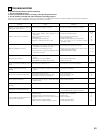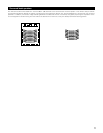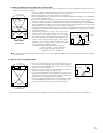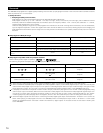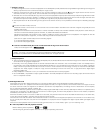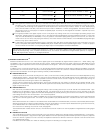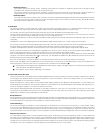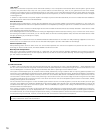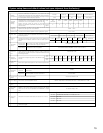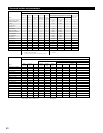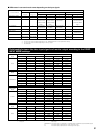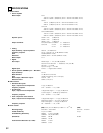
77
(5) Home THX Cinema Surround
THX is an exclusive set of standards and technologies established by the world-renowned film production company, Lucasfilm Ltd. THX grew
from George Lucas’ personal desire to make your experience of the film soundtrack, in both movie theaters and in your home theater, as
faithful as possible to what the director intended.
Movie soundtracks are mixed in special movie theaters called dubbing stages and are designed to be played back in movie theaters with
similar equipment and conditions. The soundtrack created for movie theaters is then transferred directly onto Laserdisc, VHS tape, DVD, etc.,
and is not changed for playback in a small home theater environment.
THX engineers developed patented technologies to accurately translate the sound from the movie theater environment into the home,
correcting the tonal and spatial errors that occur. On the AVR-5803, when the Home THX Cinema mode is on, THX processing is automatically
added after the Dolby Pro Logic, Dolby Digital or DTS decoder:
Re-Equalization
TM
The tonal balance of a film soundtrack will be excessively bright and harsh when played back over audio equipment in the home because film
soundtracks are designed to be played back in large movie theaters using very different professional equipment. Re-Equalization restores the
correct tonal balance for watching a movie soundtrack in a small home environment.
Timbre Matching
TM
The human ear changes our perception of a sound depending on the direction from which the sound is coming. In a movie theater, there is
an array of surround speakers so that the surround information is all around you. In a home theater, only two speakers located to the side of
your head are used. The Timbre Matching feature filters the information going to the surround speakers so that they more closely match the
tonal characteristics of the sound coming from the front speakers. This ensures seamless panning between the front and surround speakers.
Adaptive Decorrelation
TM
In a movie theater, a large number of surround speakers help create an enveloping surround sound experience, while in a home theater there
are usually only two speakers. This can make the surround speakers sound like headphones that lack spaciousness and envelopment. The
surround sounds will also collapse into the closest speaker as you move away from the middle seating position. Adaptive Decorrelation slightly
changes one surround channel’s time and phase relationship with respect to the other surround channel. This expands the listening position
and creates—with only two speakers—the same spacious surround experience as in a movie theater.
(4) DTS 96/24
The sampling frequency, number of bits and number of channels used for recording of music, etc., in studios has been increasing in recent
years, and there are a growing number of high quality signal sources, including 96 kHz/24 bit 5.1-channel sources.
For example, there are high picture/sound quality DVD video sources with 96 kHz/24 bit stereo PCM audio tracks.
However, because the data rate for these audio tracks is extremely high, there are limits to recording them on two channels only, and since
the quality of the pictures must be restricted it is common to only include still pictures.
In addition, 96 kHz/24 bit 5.1-channel surround is possible with DVD audio sources, but DVD audio players are required to play them with this
high quality.
DTS 96/24 is a multi-channel digital signal format developed by Digital Theater Systems Inc. in order to deal with this situation.
Conventional surround formats used sampling frequencies of 48 or 44.1 kHz, so 20 kHz was about the maximum playback signal frequency.
With DTS 96/24, the sampling frequency is increased to 96 or 88.2 kHz to achieve a wide frequency range of over 40 kHz.
In addition, DTS 96/24 has a resolution of 24 bits, resulting in the same frequency band and dynamic range as 96 kHz/24 bit PCM.
As with conventional DTS Surround, DTS 96/24 is compatible with a maximum of 5.1 channels, so sources recorded using DTS 96/24 can be
played in high sampling frequency, multiple channel audio with such normal media as DVD videos and CDs.
Thus, with DTS 96/24, the same 96 kHz/24 bit multi-channel surround sound as with DVD-Audio can be achieved while viewing DVD-Video
images on a conventional DVD-Video player ( 1). Furthermore, with DTS 96/24 compatible CDs, 88.2 kHz/24 bit multi-channel surround can
be achieved using normal CD/LD players ( 1).
Even with the high quality multi-channel signals, the recording time is the same as with conventional DTS surround sources.
What’s more, DTS 96/24 is fully compatible with the conventional DTS surround format, so DTS 96/24 signal sources can be played with a
sampling frequency of 48 kHz or 44.1 kHz on conventional DTS or DTS-ES surround decoders ( 2).
1: A DVD player with DTS digital output capabilities (for CD/LD players, a player with digital outputs for conventional DTS CDs/LDs) and
a disc recorded in DTS 96/24 are required.
2: The resolution is 24 or 20 bits, depending on the decoder.
• DTS Neo:6 Cinema
This mode is optimum for playing movies. Decoding is performed with emphasis on separation performance to achieve the same
atmosphere with 2-channel sources as with 6.1-channel sources.
This mode is effective for playing sources recorded in conventional surround formats as well, because the in-phase component is
assigned mainly to the center channel (C) and the reversed phase component to the surround (SL, SR and SB channels).
• DTS Neo:6 Music
This mode is suited mainly for playing music. The front channel (FL and FR) signals bypass the decoder and are played directly so there
is no loss of sound quality, and the effect of the surround signals output from the center (C) and surround (SL, SR and SB) channels
add a natural sense of expansion to the sound field.



